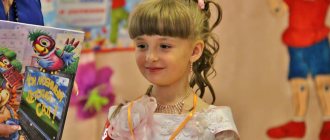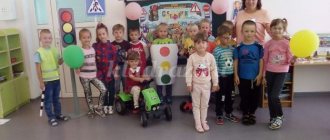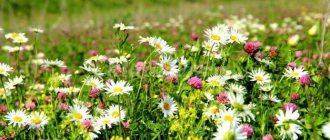Performance "The Snowman and the Sun"
The cold winter, snowy, has become so intense that even the Sun has forgotten about spring and does not come, does not shine - the forest and its forest inhabitants are cold. Children played in the clearing and made a Snowman. It’s good for the Snowman in winter, it’s beautiful. And our Snowman decided to go visit the Sun and ask him so that spring would not come. On the way he met many forest inhabitants... And you will find out what will happen next at our performance...
Conversation on the topic “Getting to know the theater” with children of the senior group
DRAMA THEATER
In a drama theater, actors are talking. The playwright talks about the characters and events in the play through dialogues.
THEATER OF BEASTS
The oldest theater exists in Moscow - the theater of V. L. Durov. “Grandfather Durov’s Corner”, where animals perform: hippopotamus, elephant, raven, pelican, raccoon and many others.
PUPPET SHOW
There are puppet theaters where spectators look not at live performers, but at puppets controlled by the performers: glove dolls, marionette dolls, shadow theater.
AUDITORIUM
Let's take a look at the auditorium. The most important place in the auditorium is the stage on which the performance is performed. The scene itself is not yet visible. It is still closed with a curtain. If you are sitting far from the stage, you will need theater binoculars, which you can bring with you or purchase from the cloakroom.
PARTERRE, BENOIR, MENS ELECTA, 1st LEVEL, 2ND LEVEL, BALCONY
ORCHESTRA PIT. Musical operas and ballets, in opera the artists sing, they are called soloists, and they are assisted by choreographers and an orchestra. The orchestra is led by a conductor so that the musicians play in the same rhythm and tempo, and in ballet the artists dance. A choreographer helps them in staging the dance. The musicians are sitting in the orchestra pit. The orchestra pit is a special room for the orchestra in the theater, located in front of the stage.
A CURTAIN. What is a theater curtain? This is a canvas that covers the stage from the audience. The performance will begin as soon as the curtain rises or moves apart, as they are sliding or rising.
SCENERY. The scenery for the performance is made in the workshop according to the sketches of the decorative artists. The scenery for the performance is made in the painting and decoration workshop according to the artists’ sketches.
PROPS. Props are fake, specially made objects of sculpture, furniture, and dishes used in theatrical performances instead of real things. A theater worker who makes props is called a prop maker. Crockery, food, weapons, and furniture can be props.
SPOTS. With the help of spotlights, lighting designers can depict sunrise or sunset, flashes of lightning, starry skies and much more on stage.
During a performance, a sound operator can turn on a soundtrack: the sound of rain or the roar of waves, the roar of a crowd or the whistle of the wind - depending on what is happening on stage at that time.
MAKE-UP MAKER. Before the performance, the make-up artist applies makeup to the actors. An experienced master can change an actor's face beyond recognition. Actors for a performance may need a variety of costumes - ancient, modern, and even fairy-tale.
The entire costume must first be designed and then drawn by the artist. The tailors will then bring his ideas to life. Masters can paint a piece of burlap in such a way that from the audience it will seem like rich brocade, velvet or silk.
Graduation album in kindergarten. Autumn and games on a walk
Do you need a kindergarten graduate album? All the information is here
Photography during an autumn walk is available only to the most organized parents who order a photographer for the kindergarten in advance. Experience shows that the demand for photography at this time is minimal. You can save money and also get photos that are unavailable at other times of the year. What to do with children on an autumn walk in kindergarten?
Of course, the main accompaniment of autumn is leaves. They can and should be used in the most active way during shooting. We randomly divide the children into groups of 4 and throw leaves into the sky. But first, of course, you need to collect them.
Before this, we can ask the children “Are you friends?” And show how you are friends. Most likely the children will start hugging. Let me note that if we simply tell the children, “Hug,” we may get angry indignation from the parents, who will say that not only did they force the children to hug, but they were also photographed not with their friends.
And here everything is fair, no unnecessary questions will arise.
Even a general photo outdoors will look great. Don’t forget to place an assistant or teacher behind the scenes who, on command, will throw the leaves up, simulating leaf fall.
Children love hide and seek and are ready to play it several times every day. Why not take advantage of this?
My favorite game is dodgeball. I try to include not the entire group of young marmosets in the activity, but break it into 2-3 subgroups. It’s easier to work this way and the children don’t overlap each other. I already wrote about this in the article: We photograph children on a walk in kindergarten. Winter Be sure to read!
And here’s a new game that’s going on with a bang – “On One Leg.” The rules are quite clear - competitions. The main thing is to voice the game and rules in an interesting and “tasty” way, and to conduct it emotionally.
Or the game “Freeze Sea Figure”, beloved by many children (and photographer Egor). I already wrote in more detail about playing outside in a previous article. Children on a walk in winter. Read, don’t be lazy.
You will definitely like it. Here are the general plans...
But here are the big ones that parents like so much.
All in all, I've given you an idea of how to take a fall walk to get some spectacular photos. But the topic has not exhausted itself. You can do things outside that are not possible in a kindergarten classroom. You can organize relay races, do more ball games, have jumping rope competitions, and an asphalt drawing competition. Or you can do nothing and just watch the children.
Of course, you will get less dense shooting and your memory card will fill up much less actively than in an organized report, but not all photographers need drive and activity. Many people prefer to work more quietly.
Please note that the children are dressed lightly and beautifully. Almost everyone has thin jackets and caps. Clothes are usually multi-colored, pleasant colors. The first frost will change this situation. Preschoolers will be dressed in winter “spacesuits” of less positive colors. Although during this period we can also get very pleasant, emotional photos.
Also, autumn photography is a great opportunity to save on graduation albums. Read about this in the next article.
Sources
- Vitruk Nikolay Vitruk N.V. Volume 2. Monographs. Comments. 1963-1990; Higher school - Moscow, 1979. - 180 p.
- Trubnikov, P.Ya. Protection of civil rights in court / P.Ya. Trubnikov. - M.: Legal literature, 1990. - 224 p.
- Ivan, Aleksandrovich Zenin Civil and trade law of foreign countries / Ivan Aleksandrovich Zenin. - M.: Yurayt, 2009. - 150 p.
- Lukin E. E. International private law. Answers to exam papers; Scientific book - M., 2009. - 364 p.
- Alexander, Aleksandrovich Biryukov Handbook for legal counsel. Educational and practical manual / Alexander Aleksandrovich Biryukov. - M.: Prospekt, 1996. - 405 p.
Calendar planning on the theme “Theater Day”
Lyudmila Abramenko
Calendar planning on the theme “Theater Day”
Calendar planning of the group’s work : “Smart guys and smart girls”
on
topic : “
Theater Day ” March IV week 03/20-03/25/2017
Goals: Introducing and developing a positive attitude towards theatrical art
Final event: Dramatization of the fairy tale “Teremok”
for the younger group
Morning exercises complex No. 15.
Invigorating gymnastics ___
Developing self-care skills, improving the ability to tie hats and button jackets.
Working with parents Poster of children's performances for the current month.
NNOD Joint activity during special moments Individual work Creating conditions for independent activity
Monday I half day Cognitive development
Conversation – “ Theater ”
- what it is?
Goal: to introduce children to the history of the theater . Continue to cultivate a culture of behavior in the theater , deepen children's knowledge about different types of theater .
(Music. According to the plan of the music director)
Conversations about the rules of behavior in
the theater - To give children an idea of the rules of behavior in public places;
to form a personal attitude towards non-compliance and violation of rules. Plot-role-playing game “We came to the theater ”
.- introduce the rules of behavior in
the theater ; arouse interest and desire to play (play the role of “cashier”
,
“ticketer”
,
“spectator”
);
cultivate friendly relationships. Place animal masks
in the center of theatrical Place diagrams for building an auditorium in the center of constructive games.
Walk: Look at the card index.
II half of the day Evening. Regional component.
"My friends"
- cultivate goodwill.
Psycho-gymnastics. “Different faces”
- Encourage children to experiment with their appearance
(facial expressions, gestures)
. Develop children's ability to switch from one image to another.
Games “Pass the pose”, “We won’t tell you what we did.”
Walk: See card index
Working with parents to take their child to a theater performance
Reading fiction by R. N. S. “Teremok”
Tuesday I half day (Modeling)
My favorite cartoon character
Ts be able to convey the characteristic features of a fairy-tale hero.
Cognitive development (FEMP)
Solving logical problems - developing attention, thinking, logic
(Physical training according to plan
physical Head) Conversation about theatrical professions . - continue to introduce the professions: artist, prompter, stagehand, prop maker, costume designer
Presentation "Children's Theater "
S/r game “We are artists”
(production of a fairy tale well known to children)
. - Introduce children to the scenario
(production)
of a fairy tale. Teach children to express their opinion about a fairy tale in a new way. Complete the tale with the necessary episodes. Cultivate the ability to listen to the opinions of others, develop endurance and patience. Place capes and raincoats in the center of creative games.
Looking at paintings and photographs about the Theatre .
Walk: Look at the card index
II half day
Children's games with sounding instruments. Purpose: to give children an idea of the musical design of performances.
Walk: See card index
Working with parents updating attributes for the fairy tale “Teremok”
Reading fiction Fairy tale “Mitten”
Wednesday I half day (Speech development)
Story on “How the Chicken Got Lost”
.
C Lead the children to independently continue and complete the story started by the teacher.
(Music)
According to the music director's plan
Physical education on the street) Display of RNS using bi-ba-bo toys
dialogues: wolf - fox, wolf - bear, mouse - wolf.
Goal: Develop the ability to build dialogues between characters in imaginary circumstances
Looking at bi-ba-bo dolls with children. A conversation about how to properly use dolls, which is a tool for driving bi-ba-bo dolls.
Guessing riddles about literary characters
Place glass funnels, transparent glasses, various filters (gauze, colored pebbles, cotton pads, charcoal)
.
Walk: See card index
II half day
Looking at photographs of the opera house , illustrations for the opera “The Snow Maiden”
(to the ballet "The Nutcracker"
)
Walk: See card index
Working with parents Making theater posters
Reading fiction by A. S. Pushkin “The Tale of the Fisherman and the Fish”
Thursday I half day Cognitive development
Journey to the theater
To consolidate and expand children’s ideas about the work of actors in the theater
(drawing)
"Parsley - the folk fair hero"
C - Teach children to draw a portrait of parsley using non-traditional forms (outlining their palm with a pencil - this is a cap, and finishing drawing the face)
Musical leisure. Getting to know puppets." - Improve puppeteering techniques, consolidate knowledge about the rules for manipulating theatrical puppets ..
Introduction to musical theaters . Purpose: To give an idea of the various genres of musical theater , such as “opera”, “ballet”, “musical”, “musical fairy tale”.
Place masks for cutting and coloring in the center of the art.
Place facial pictures of a person in the center of didactic games.
Walk: See card index
II half day
Listening to recordings of musical fairy tales according to the age of children.
Walk: See card index
“My favorite fairy-tale hero” with the child
Reading fiction by A. S. Pushkin “The Tale of the Dead Princess and the Seven Knights”
Friday 1st half day Speech development
Certificate
Repetition of what has been covered
Shumaeva page 106
(Drawing)
Artist in the theater
C - creating conditions for children to master the means and techniques of creating theatrical scenery , developing information culture
Physical Culture
According to the plan of the physical education instructor. Introducing children to finger theatre , mitten theatre , shadow theater . - give children an idea about the features of this type of theater .
Examination of illustrations “ Theatrical scenery ”
,
“
Theatrical Costumes ” Viewing excerpts from the musical films “Mama”
(based on the fairy tale
“The Wolf and the Seven Little Goats”
, the ballet
“The Nutcracker”
, the musical
“The Little Mermaid”
, the opera
“The Snow Maiden”
, etc.
Adding attributes to theatrical games
“Heroes of children's fairy tales.”
Walk: See card index
II half day
Exercise “Tell the poems of A. Barto using gestures and facial expressions”
Learn to use intonations by pronouncing phrases sad, happy, angry, surprised.
Walk: See card index
Work with parents to remind them to pick up pajamas.
Reading fictionA. S. Pushkin “The Tale of the Priest and His Worker Balda”






